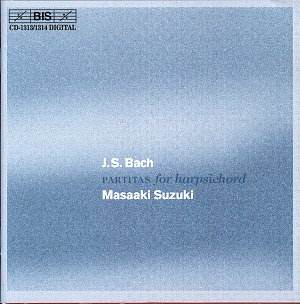By Bach's time keyboard instruments had come to dominate
solo music-making, and since there were no recitals of the kind we know
today, his fundamental keyboard style was a private one without regard
to ostentation. The exact date of composition of his set of six Partitas
is not known, but they were probably written before 1723, during his
years at the Court of Anhalt-Cöthen. They were published in Leipzig
in the years after 1726, under the title of Clavierübung (Keyboard
Practice), along with the sets of English and French Suites.
The Partitas are typical in their range and variety
of dance or dance-like movements, with thematic material which achieves
both unity and diversity. Although they have much in common each of
them has its own special identity, brought by choices of key, particular
dance forms and approaches of detail to individual movements.
In an important sense it is probably unfair to listen
to all six pieces in sequence, since Bach almost certainly did not envisage
this. For all Masaaki Suzuki's undoubted talent, he does not really
achieve a different perspective in each case. But listen to any of the
partitas with fresh ears, and the performance will please.
Tempi and articulation are pleasing. Just occasionally,
as in the Courante of Partita No. 1, the rhythm can drag a little, and
the same might be said of the slower tempo of the Sarabande that follows.
To some extent these things might be perceived as a matter of taste,
however, and in Bach, Suzuki possesses excellent judgement and deep
understanding, as we know both from his keyboard discs and his marvellous
cantata and passion recordings.
It is important to recognise the strengths and nature
of the recorded sound. As ever with BIS, the sound is powerfully captured,
clear and directly focused. But played at a 'normal' volume it is somewhat
overpowering, larger than life as it were. Play the disc at a lower
setting and everything seems much more natural and pleasing.
Since Partitas Nos. 4 and 6 are rather longer than
their fellows, at 30+ instead of 20+ minutes, BIS have cleverly programmed
the collection to allow all six pieces to be contained on two discs
of more than 80 minutes each. This is thoughtful and commendable, while
the packaging and insert notes are of an excellent standard too.
This set is probably the best solo disc Suzuki has
yet offered us. Of the six performances my favourite is the great Partita
No. 6, a substantial piece which takes the familiar dance movement sequence
to new heights. The opening Toccata is a really challenging movement
for all involved, a veritable tour de force, and this performance brings
suitably virtuoso dexterity.
Whether you prefer this music played on the harpsichord
or on the piano, the six partitas remain among the key works in the
literature of keyboard music. The answer for the serious collector is
surely to possess at least one recording on each instrument. And if
it's the harpsichord you're particularly looking for, then you need
look no further than Masaaki Suzuki.
Terry Barfoot

